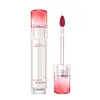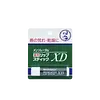What's inside
What's inside
 Key Ingredients
Key Ingredients

No key ingredients
 Benefits
Benefits

No benefits
 Concerns
Concerns

 Ingredients Side-by-side
Ingredients Side-by-side

Diisostearyl Malate
EmollientWater
Skin ConditioningBis-Diglyceryl Polyacyladipate-2
EmollientTrimethylsiloxyphenyl Dimethicone
Bis-Behenyl/Isostearyl/Phytosteryl Dimer Dilinoleyl Dimer Dilinoleate
EmollientPolyphenylsilsesquioxane
Diglycerin
HumectantCetyl PEG/PPG-10/1 Dimethicone
EmulsifyingPolysorbate 60
Emulsifying1,2-Hexanediol
Skin ConditioningHydroxyethyl Acrylate/Sodium Acryloyldimethyl Taurate Copolymer
Emulsion StabilisingSqualene
EmollientBehenyl Alcohol
EmollientPhenoxyethanol
PreservativeCaprylyl Glycol
EmollientTitanium Dioxide
Cosmetic ColorantCI 15985
Cosmetic ColorantAcid Red 33
Parfum
MaskingSorbitan Isostearate
EmulsifyingAluminum Hydroxide Oxide
AntimicrobialAmmonium Polyacrylate
StabilisingCI 42090
Cosmetic ColorantCaprylic/Capric Triglyceride
MaskingPentaerythrityl Tetra-Di-T-Butyl Hydroxyhydrocinnamate
AntioxidantRose Extract
Skin ConditioningDiisostearyl Malate, Water, Bis-Diglyceryl Polyacyladipate-2, Trimethylsiloxyphenyl Dimethicone, Bis-Behenyl/Isostearyl/Phytosteryl Dimer Dilinoleyl Dimer Dilinoleate, Polyphenylsilsesquioxane, Diglycerin, Cetyl PEG/PPG-10/1 Dimethicone, Polysorbate 60, 1,2-Hexanediol, Hydroxyethyl Acrylate/Sodium Acryloyldimethyl Taurate Copolymer, Squalene, Behenyl Alcohol, Phenoxyethanol, Caprylyl Glycol, Titanium Dioxide, CI 15985, Acid Red 33, Parfum, Sorbitan Isostearate, Aluminum Hydroxide Oxide, Ammonium Polyacrylate, CI 42090, Caprylic/Capric Triglyceride, Pentaerythrityl Tetra-Di-T-Butyl Hydroxyhydrocinnamate, Rose Extract
Ingredients Explained
These ingredients are found in both products.
Ingredients higher up in an ingredient list are typically present in a larger amount.
Parfum is a catch-all term for an ingredient or more that is used to give a scent to products.
Also called "fragrance", this ingredient can be a blend of hundreds of chemicals or plant oils. This means every product with "fragrance" or "parfum" in the ingredients list is a different mixture.
For instance, Habanolide is a proprietary trade name for a specific aroma chemical. When used as a fragrance ingredient in cosmetics, most aroma chemicals fall under the broad labeling category of “FRAGRANCE” or “PARFUM” according to EU and US regulations.
The term 'parfum' or 'fragrance' is not regulated in many countries. In many cases, it is up to the brand to define this term.
For instance, many brands choose to label themselves as "fragrance-free" because they are not using synthetic fragrances. However, their products may still contain ingredients such as essential oils that are considered a fragrance by INCI standards.
One example is Calendula flower extract. Calendula is an essential oil that still imparts a scent or 'fragrance'.
Depending on the blend, the ingredients in the mixture can cause allergies and sensitivities on the skin. Some ingredients that are known EU allergens include linalool and citronellol.
Parfum can also be used to mask or cover an unpleasant scent.
The bottom line is: not all fragrances/parfum/ingredients are created equally. If you are worried about fragrances, we recommend taking a closer look at an ingredient. And of course, we always recommend speaking with a professional.
Learn more about Parfum